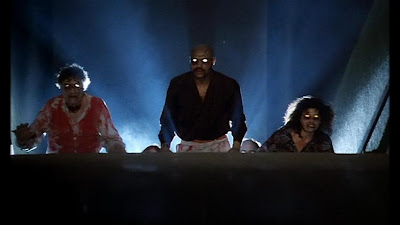(1985) Directed by Lamberto Bava; Written by Dario Argento,
Lamberto Bava, Dardano Sacchetti and Franco Ferrini; Starring: Urbano
Barberini, Natasha Hovey, Karl Zinny and Fiore Argento; Available on DVD
Rating: ***
I wanted to start off by expressing my sincerest thanks to
Kevin J. Olson at Hugo Stiglitz Makes Movies for hosting this third annual Italian Horror Blogathon.
This is my second go-round, after last
year’s review of Cemetery Man, and I don’t feel that I’m any closer to cracking the enigma of Italian
horror cinema, but I’m enjoying the ride. This beguiling, often frustrating category keeps me returning for more
like some virtual Stockholm Syndrome. This
year, I chose to discuss the seminal 1980s gorefest, Demons, from director/co-writer Lamberto (son of Mario) Bava.
Demons doesn’t
make a whole lot of sense. It plays more
like a fever dream than a coherent narrative, with everything rushing by in a
sort of hazy blur. I practically hurt my
brain, straining to find the subversive social commentary before coming to the
realization that there was none to be found. There, I said it. I feel better getting that off my chest. Let’s move on, shall we?
The opening scene takes place in the Berlin subway, where a
mute man in a silver mask (Michele Soavi*) hands out passes to a free screening
at the Metropole movie theater. Most of
the film takes place in the theater, as we observe the patrons clambering for a
way out, wishing that they’d stayed at home.
There’s something instantly compelling about watching people in a cinema
watching another movie, like staring into one of those trick mirrors that show
an endless series of mirrors within. The
movie-within-a-movie concept has been done before, but never to such gory
effect. The audience members derive vicarious
thrills by watching a movie (the title is never mentioned) about demons and an ancient prophecy by
Nostradamus, until everything gets a little too real on the other side of the
screen. Everything quickly devolves into
chaos as the action in the theater mimics the atrocities in the film.
* Mr. Soavi (who
coincidentally directed Cemetery Man)
really earned his paycheck with this movie, by playing two roles in the film,
and serving as the assistant director.
Bava commented that he wanted to set his demons apart from
the zombies in George Romero’s Living Dead
films. Indeed, Demons is faster paced and more frenetic than most other zombie
flicks, with the titular creatures possessing a sort of rabid energy. While short on logic or believability, many
of the scenes convey a certain manic je ne sais quoi, where absurdity rules
supreme. You can’t predict what’s coming
next. Some highlights include a fully
grown demon emerging from the back of one of the unfortunate theater patrons,
and film’s nominal hero, George (Urbano Barberini), riding a motorcycle down
the theater aisle while slicing demons apart with a katana. We also witness a group of coke-fueled punks
* stumble into the theater, despite the fact that none of the theater-goers
seem to be able to find an exit. In
another mind-numbingly inexplicable scene, a helicopter suddenly crashes
through the theater’s ceiling (asked why, Bava simply replied that he liked the
idea).
* In this case, it’s not mere hyperbole. No, really.
We witness four punks snorting cocaine from a can of coke. Frankly, I’m surprised the Coca-Cola
Company didn’t sue because of that scene.
Ahh.. but those were the 80s.
(Spoiler alert: If
you want to remain spoiler free, I recommend skipping ahead to the last paragraph.)
In the film’s climax, it’s revealed that the demons are not
confined to the theater, but outside (presumably everywhere) as well. This seems to suggest a cause-and-effect relationship
between the demon infestation inside and outside the theater, with the movie within
a movie being the common link. Is it art imitating life, or life imitating art? Or was everything predestined to happen this
way from the start? Demons is short on answers, and doesn’t provide any solace for
those who are accustomed to a clear resolution.
The only thing that appears certain, by the film’s conclusion, is that there’s
nowhere safe to run to.
There’s not a lot to be said about the characters, but
that’s probably not the point. The story
is told in broad strokes, in which the frenzied audience could be seen as a single
character. They react to the demons as
one large organism would react to an infectious disease.
Demons works on a
primal level, achieving its modest goals successfully. Audiences didn’t go to this for nuanced
performances or insightful social commentary.
They wanted to see lots of goopy monsters run amok, and their victims
meet horrible ends. In this respect it
succeeds admirably. It won’t likely change
your views about Italian horror and its excesses, but you probably know where
you stood with this genre already. Gorehounds
and fans of 80s horror will find much to love here; all others need not apply.







And the ending is genius.
ReplyDeleteDefinitely not the sort of thing that would have come out of Hollywood.
ReplyDeleteThat helicopter has got to be one of the best Deus Ex Machinas ever put to film.
ReplyDeleteAbsolutely! It's a perfect textbook example. Thanks for stopping by, Eric!
ReplyDeleteI've always thought of the rediculous ending as the movie universe spilling into the real world.
ReplyDeleteHey, I'll buy that. Love the surreal touches in this film.
Delete